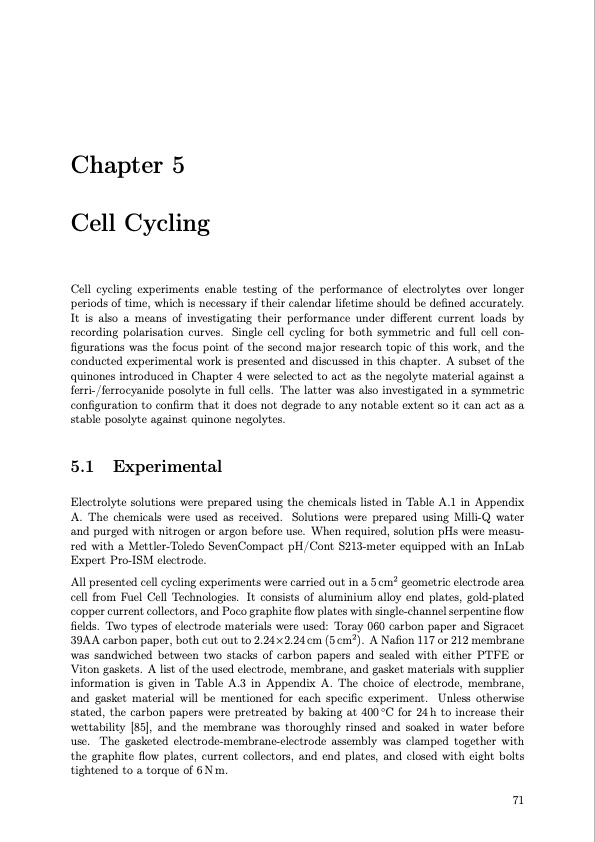
PDF Publication Title:
Text from PDF Page: 092
Chapter 5 Cell Cycling Cell cycling experiments enable testing of the performance of electrolytes over longer periods of time, which is necessary if their calendar lifetime should be defined accurately. It is also a means of investigating their performance under different current loads by recording polarisation curves. Single cell cycling for both symmetric and full cell con- figurations was the focus point of the second major research topic of this work, and the conducted experimental work is presented and discussed in this chapter. A subset of the quinones introduced in Chapter 4 were selected to act as the negolyte material against a ferri-/ferrocyanide posolyte in full cells. The latter was also investigated in a symmetric configuration to confirm that it does not degrade to any notable extent so it can act as a stable posolyte against quinone negolytes. 5.1 Experimental Electrolyte solutions were prepared using the chemicals listed in Table A.1 in Appendix A. The chemicals were used as received. Solutions were prepared using Milli-Q water and purged with nitrogen or argon before use. When required, solution pHs were measu- red with a Mettler-Toledo SevenCompact pH/Cont S213-meter equipped with an InLab Expert Pro-ISM electrode. All presented cell cycling experiments were carried out in a 5 cm2 geometric electrode area cell from Fuel Cell Technologies. It consists of aluminium alloy end plates, gold-plated copper current collectors, and Poco graphite flow plates with single-channel serpentine flow fields. Two types of electrode materials were used: Toray 060 carbon paper and Sigracet 39AA carbon paper, both cut out to 2.24×2.24 cm (5 cm2). A Nafion 117 or 212 membrane was sandwiched between two stacks of carbon papers and sealed with either PTFE or Viton gaskets. A list of the used electrode, membrane, and gasket materials with supplier information is given in Table A.3 in Appendix A. The choice of electrode, membrane, and gasket material will be mentioned for each specific experiment. Unless otherwise stated, the carbon papers were pretreated by baking at 400◦C for 24h to increase their wettability [85], and the membrane was thoroughly rinsed and soaked in water before use. The gasketed electrode-membrane-electrode assembly was clamped together with the graphite flow plates, current collectors, and end plates, and closed with eight bolts tightened to a torque of 6 N m. 71PDF Image | Organic Redox Flow Batteries 2023

PDF Search Title:
Organic Redox Flow Batteries 2023Original File Name Searched:
PhD_thesis_final_dorhoff_4_.pdfDIY PDF Search: Google It | Yahoo | Bing
Salgenx Redox Flow Battery Technology: Salt water flow battery technology with low cost and great energy density that can be used for power storage and thermal storage. Let us de-risk your production using our license. Our aqueous flow battery is less cost than Tesla Megapack and available faster. Redox flow battery. No membrane needed like with Vanadium, or Bromine. Salgenx flow battery
| CONTACT TEL: 608-238-6001 Email: greg@salgenx.com | RSS | AMP |